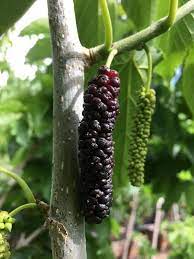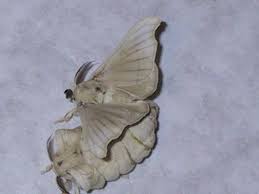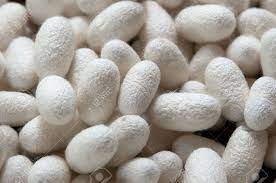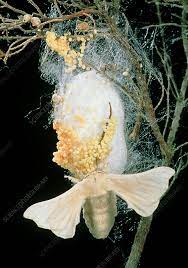Sericulture- An overview
Sericulture or silk production refers to the production of raw silk by raising caterpillars (larvae), particularly those of the domesticated silkworm (Bombyx mori). Silk production includes breeding and management of silk worms (larvae or caterpillars of Bombyx mori).

The production of silk generally involves two processes:
- Rearing and care of the silkworm from the egg stage through completion of the cocoon and then collection and processing to extract raw silk fibers from them.
- Production of mulberry trees that provide leaves upon which the worms feed.

There are more than five hundred types of silk spinning worms, but only four namely mulberry, tasar, eri, and muga are commercially exploited for the production of natural silk. The latter three varieties are wild/forest silk and branded as “Vanya Silk”.
Currently India is the only country that produces all four types of natural silks. India stands 2nd position in the production of raw silk after china, while Mysore alone accounts for about 76% of total production of raw silk in the country.
Process
- The silkworm caterpillar builds its cocoon by producing and surrounding itself with a long filament or continuous fibers.
- Liquid secretes from two large glands within the insect emerge from a single exit tube (spinneret) in the head, become hard when expose to air and forms twin filaments composed of fibroin, a protein material.
- A second pair of glands secretes a gummy substance called sericin, that cements the two filaments together. Because an emerging moth would break the cocoon filament, the larva is killed in the cocoon by steam or hot air at the chrysalis stage.

Reeling and Throwing- Yarn making
- Silk is a continuous filament within each cocoon, having a usable length of about 600 to 900 metres.
- Silk is freed by softening the binding sericin and then locating the filament end, and unwinding the filaments from several cocoons at the same time is called reeling.
- Since a single silk strand is too thin for most uses, several silk strands are twisted together to make thicker, stronger yarn, a process called throwing. This process produces various yarns differs according to the amount and direction of the twist imparted.
- Silk containing sericin is called raw silk. The gummy substance which provides protection during processing, is usually retained until the yarn or fabric stage, and is removed by boiling the silk in soap and water. It makes the silk soft and lustrous, with weight reduced by as much as 30%.
- Spun silk is made from short lengths obtained from damaged cocoons or broken off during processing, twisted together to make yarn.
- The thickness of silk filament yarn is expressed in terms of denier, the number of grams of weight per 9,000 metres of length.

What is weighting?
It is the process wherein silk is treated with a finishing substance, like metallic salts to increase weight, add density, and improve draping quality.
Silk Properties
- The process of Degumming makes silk lustrous and semi-transparent, with a smooth surface that does not readily retain soil.
- Silk has good strength, resisting breakage when subjected to weights of about 4 grams/denier. Wetting reduces strength by about 15–25%.
- A silk filament can be stretched about 20% beyond its original length before breaking but does not immediately resume its original length when stretched more than about 2%.
- Silk has lower density than cotton, wool, and rayon, and is moisture-absorbent, retaining as much as a third of its weight in moisture without feeling damp.
- Silk has excellent dyeing properties. It is more heat-resistant than wool, decomposing at about 170° C (340° F).
- Silk loses strength over a long period of time without appropriate storage conditions and tends to decompose with extensive exposure to sunlight but is rarely attacked by mildew. It is not harmed by mild alkaline solutions and common dry-cleaning solvents.
Types of Silkworms
- Mulberry: Mulberry silk comes from the silkworm ‘Bombyx mori’, which solely feeds on the leaves of mulberry plant. Most of the commercial silk produced in the world comes from this variety. Origin: China.
- Tasar: This is coarse silk, copperish colour mainly used for furnishing and interiors. Tasar silk is produced by the silkworm, Antheraea mylitta which primarily thrives on the food plants, Asan and Arjun.
- Oak Tasar: origin: India. It is a finer variety of tasar generated by the silkworm, Antheraea proyeli J. in India. This silkworm feeds on natural plants of oak, found in abundance in sub-Himalayan belt of India.
- Eri: Unlike other varieties of silk, Eri is a multivoltine silk spun from open-ended cocoons. It is the product of domesticated silkworm, Philosamia ricini that feeds mainly on castor leaves. Eri is also known as Endi or Errandi. Origin: India.
- Muga: Muga is obtained from semi-domesticated multivoltine silk, Antheraea assamensis that feeds on aromatic leaves of som and soalu plants and are reared on trees similar to that of tasar. Muga silk is yellow golden in colour, prerogative of India and the pride of Assam Origin: India.
Voltinism
Voltinism is the ability of many insect groups to produce one to several generations a year. Species producing one generation a year is called univoltine, producing two generations a year called bivoltine, producing several generations called multivoltine. In Bombyx mori, all the three types of voltinism are found.
- Univoltine races are not suitable for summer and winter rearing because larvae are weak against unfavourable conditions. Larval weight is comparatively higher and cocoons are heavy. They lay only diapausing eggs. All European races are univoltine. Example: E16.
- Bivoltine lay both non-hibernating eggs too. Cocoon weight, leaf consumption to cocoon production is less and cocoons quality is also inferior as compared to univoltine race. Most of the temperate races are bivoltines. Example: NB7, KA, NB4D2, NB18.
- Multivoltine races produce more than 5-6 generations per year, larvae are robust can tolerate fluctuating environment hence best suited for tropical climates. They lay only non-diapausing eggs, e.g., pure mysore.
Bivoltine race are relatively poor disease resistant, can’t tolerate temperature beyond 280C, their eggs can be preserved up to 6-10 months, whereas filament length ranges from 1000-2600m/cocoon.
Multivoltine race are relatively more disease resistant, can tolerate temperature beyond 280C, but their eggs can be preserved for more than 20 days, whereas filament length ranges from 400-500m/cocoon.
Moultinism
Silkworms, based on number of moulting throughout the life cycle are of four types: Tri moulters, moult three times during larval period; Tetra moulters, moult four times during their larval stage; Penta moulters, moult five times during their larval period.
Disease & Pests
There are four main disease which causes upto 40% of total crop loss, are Pebrine (Protozoan disease), Flecherie (Bacterial disease), Grasserie (Viral disease), Muscardine (Fungal disease).
Besides, there is Uzi fly considered as serious endo- larval parasitoid of the silkworm. Due to infestation of Uzi fly, yield of cocoons is reduced tremendously.
See also…
Biofloc Technology